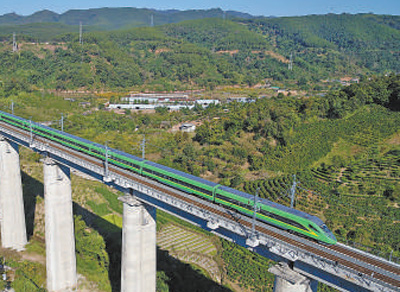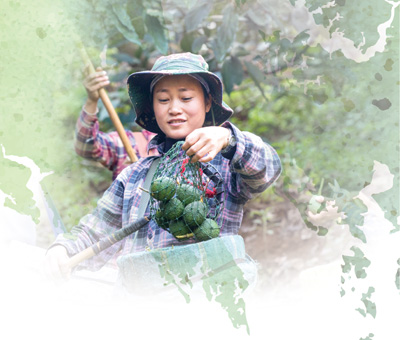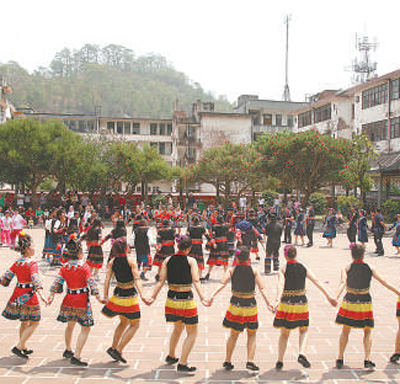Ethnic unity promotes development of industries in SW China's Yunnan

A worker picks coffee beans at a coffee plantation in Simao district, Pu'er city, southwest China's Yunnan Province. (Photo/Wang Chengji)
In 1951 on New Year's Day, representatives from various ethnic groups erected an oath-taking monument promoting ethnic unity in Pu'er city, southwest China's Yunnan Province. Over the past 70-plus years, the monument has stood witness to the significant transformations the city has experienced, as well as the enduring unity that has been steadfastly maintained.
Today, Pu'er has become one of the largest coffee-producing regions in the country, with the avocado industry also showing steady growth. Distinctive industries are rapidly emerging, and the city's infrastructure is continuously advancing. The presence of the China-Laos Railway, which passes through the city, positions Pu'er as a key frontier for opening up.
Improved infrastructure, improved livelihoods
In 1950, representatives of various ethnic groups embarked on a journey to Beijing to attend a ceremony celebrating China's National Day on Oct. 1. To catch their flight in Kunming, the capital of Yunnan Province, they departed at the end of August and arrived in Kunming over 20 days later.

A train runs on the China-Laos Railway in southwest China's Yunnan Province. (Photo/Wang Chengji)
"Today, Pu'er boasts two airports, and the city's Ning'er Hani and Yi Autonomous County has a railway station along the China-Laos Railway. It now only takes a day to travel from the villages to Beijing," stated Wu Zhuoyi, a docent at the National Unity Park located in Ning'er.
Today, all villages in Pu'er city have electricity access, and the processing of Pu'er tea, a local specialty, is powered by clean energy. In addition, areas where town and township governments are located are equipped with 5G base stations, while all administrative villages, schools, and clinics are connected to an optical fiber network.
The local people's way of living and production has also evolved. For example, the tradition of dancing around a bonfire has not only enriched the cultural life of local residents but also become a tourist attraction. The villages feature well-organized residential houses, spacious and clean roads, picturesque courtyards, serene landscapes, vibrant ethnic culture, and a flourishing ecological industry.
In the recent three years, Ning'er county has allocated a total of 127 million yuan (approximately $18.11 million) to enhance livelihoods. The basic medical insurance coverage rate has exceeded 95 percent, and nine-year compulsory education has a consolidation rate of 93.79 percent.
From specialty industries to the integration of culture and tourism, more prosperity for the people

A woman of the Hani ethnic group picks avocados at a plantation in Mangxin town, Menglian Dai, Lahu and Wa Autonomous County, Pu'er city, southwest China's Yunnan Province. (Photo/Yan Sanka)
Sixty-two-year-old Cai Fengying, a member of the Hani ethnic group, has dedicated over 50 years to practicing Hani embroidery. Through the collective efforts of Cai and fellow embroiderers, this ancient craft is experiencing a rejuvenation. Cai skillfully incorporates Hani embroidery elements into everyday items such as chopstick bags, flashlight bags, and curtains, introducing more individuals to the beauty of Hani embroidery and attire.
In Mengxian town of Ning'er county, 66 households generated more than 61,000 yuan by participating in forestry carbon sink trading. Serving as a pilot region for this initiative, Ning'er county is innovating ways to convert its lucid waters and lush mountains into economic opportunities, motivating residents to participate in environmental conservation activities.
Menglian Dai, Lahu and Wa Autonomous County is the largest avocado producing area in the country. Qi Jiazhu, general manager of Pu'er Lvyin Biology Co., Ltd., has led his team to develop a new path for the avocado industry's development. It has launched a development model incorporating Party organizations, leading enterprises, cooperatives, and farming households, which share common interests. Through this mode, many local residents have benefited economically from the industry's growth.
Building a beautiful homeland together, ethnic unity also grows

People of ethnic groups dance joyfully in Anban town, Zhenyuan Yi, Hani and Lahu Autonomous County, Pu'er city, southwest China's Yunnan Province. (Photo/Lin Changyun)
"Some representatives had concerns and were reluctant to participate in the National Day celebrations in 1950. The team members of the working group put in a lot of effort to persuade them," Wu said, mentioning that back then, the primary obstacle was not the steep mountains and rugged terrain, but rather the barriers between people, revealing a lack of closeness in their hearts.
Over 70 years later, those barriers have disappeared, and various ethnic groups are closely united like pomegranate seeds. "Members of different ethnic groups are often found in one household register, with intermarriage between different ethnic groups being a common occurrence," stated Li Hongfei, a police officer from Simao district.

Photo shows the scenery of Yongqing tea garden in Yixiang town, Simao district, Pu'er city, southwest China's Yunnan Province. (Photo/Zi Han)
Today in Pu'er, diverse ethnic groups come together to celebrate each other's festivals. They gather in traditional attire, sing ethnic songs and dance, turning the festivals of various ethnic groups into grand gatherings for all.
In Menglian, the Dai, Lahu, and Wa ethnic groups traditionally collaborate during busy farming seasons, supporting each other. In recent years, Menglian has promoted the sharing of agricultural experiences, advanced techniques, and recommendations for emerging industries among farming households of the three ethnic groups. This has led to a development pattern focused on sharing techniques to enhance production. As a result, industries such as coffee, macadamia nuts, and avocados are experiencing rapid growth.
Photos
Related Stories
Copyright © 2024 People's Daily Online. All Rights Reserved.









